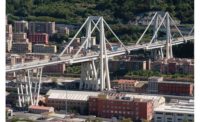More than 135 people are dead following the Oct. 30 collapse of a 143-year-old pedestrian suspension bridge in Gujarat state, India, on which roughly 400 people were crossing the Machchhu River at the time. About 196 people were rescued when the 1.25 m (4 ft)-wide, 230 m (755 ft)-long span—known as the Jhoolta Pul (Swinging Bridge)—fell near the town of Morbi, said local officials.
Adel Jemah, senior vice president and head of Saudi Arabia operations at Hill International and a structural engineer with experience ii suspension bridge design, offered one analysis after viewing a video of the collapse.
“The vibrations [caused by people using the bridge] were not normal. They caused resonance and exceeded the natural frequency, causing the collapse,” he told ENR from Riyadh. The bridge had a capacity of 125 people. “Structural items like cables and mast cannot take vibrations as they can cause resonance and collapse.”
On maintenance that was done by the private Oreva Group, Jemah said while there was no information released, “The cables look as though they are new. It is fine if they are connected in a proper manner ... something may have been changed in the original design.” He said bridges are designed for a certain lifespan, which in this case could have been exceeded. “A chain is only strongest as its weakest link.”
Today all that is left of the bridge is part of the metal deck hanging down into the river with splintered steel cables. Concerns over safety following the collapse led to closure of some other suspension bridges in India.
Attention has turned to the Oreva Group, an industrial company mainly known as a manufacturer of clocks and other appliances, that has a contract for operation and maintenance of the bridge through 2037. The bridge was closed for renovation in March and recently reopened—a month earlier than planned—possibly to be ready in time for the Gujarati new year on Oct. 26. Sandeep Singh, Municipal Chief Officer confirmed to India Today that a "fitness certificate" was not issued to the bridge.
Oreva is also the concessionaire charging tolls to those crossing the bridge, but it is not clear how the firm was awarded the operations and maintenance contract.
At a private press conference on Oct. 26, Oreva Managing Director Jaisukhbhai Patel said that “following the repairs, which were done with modified technical specifications ... the bridge won't need any major repair work for at least eight to 10 years now."
He has not made any public statements since the collapse.
Inaugurated in 1879 by then-Mumbai Gov. Richard Temple, the bridge was built as a tribute to the progressive and scientific nature of the rulers of the city of Morbi, according to the district collectorate website. The bridge connected two palaces on either side. Its original construction materials were imported from the U.K.



Post a comment to this article
Report Abusive Comment